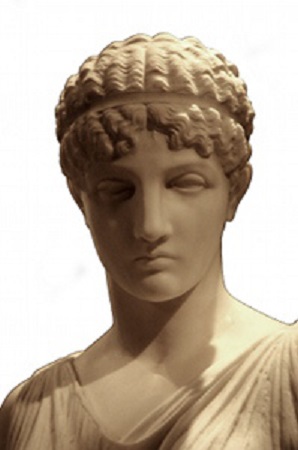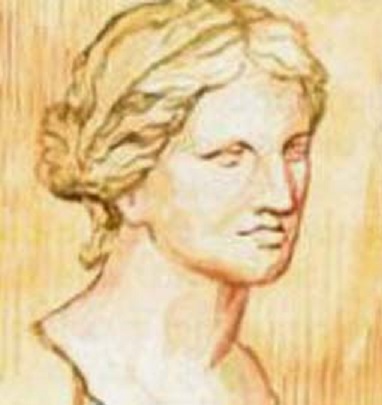
Theano

Theano (/θɪˈænoʊ/; Greek: Θεανώ; fl. 6th-century BC), or Theano of Crotone, is the name given to perhaps two Pythagorean philosophers. She has been called the pupil, daughter and wife of Pythagoras, although others made her the wife of Brontinus. Her place of birth and the identity of her father are just as uncertain, leading some authors to suggest that there was more than one person whose details have become merged (these are sometimes referred to as Theano I and Theano II). A few fragments and letters ascribed to her have survived which are of uncertain authorship.
Theano – A Woman Who Ruled the Pythagoras School
In ancient Greece, it was not very common to see a female scientist. However, history remembers the names of the women who made their mark in those times. One of them was Theano, the wife of the famous Pythagoras.
Researchers still cannot pinpoint what her role was in Pythagoras’ research. The famed mathematician and philosopher is known for his great theories, but did he accomplish his work on his own, or did Theano have a part to play in his discoveries as well?
Pythagoras was born on the island of Samos, near the coast of Asia Minor. During the 82 years of his life (582 – 500 BC), he founded a school of philosophy, created or described a few very important theories (which became the fundamentals of many sciences) and educated an unknown number of students who continued his work. He was also lucky to have married a woman with an unusual intellect, extraordinary skills to understand the ways of the world, and enough patience to become a scientist.
The Scientist’s Muse
Theano was born circa 546 BC, probably on Crete. Traditionally she is known as Theano of Croton. Her early life is not well known, but she is believed to have been a daughter of Brontinus the Orphic. Her father was a member of a religious group focused on the cult of Osiris. This group believed in reincarnation, and it is known that the Pythagoreans were inspired by their philosophy as well. This suggests that Theano may have also motivated her husband in many ways. Moreover, Brontinus and Theano became disciples of Pythagoras.
With time, they became a family as well and Theano had five children, two sons and three daughters, with Pythagoras. One of the sons was named Telauges and their daughters were named Damo, Myria and Arginote. The name of the second son has been forgotten over the years (most researchers propose, as the name of the second son, Mnesarchus).
Some researchers suggest that there could be more than one woman now identified as Theano. However, it seems more likely that it was just one person who used different pseudonyms. The real position of Theano in the Pythagorean School is unknown. Some researchers suggest that most of the writings which are known from other ancient books were made by the woman.
On the other hand, the old school of specialists in ancient Greek philosophy suggest that all of the writings which are believed to have been created by Theano were actually written by men, who used her name as a pseudonym. This belief has also been used for all of the writings which were published under the name of Pythagoras.
Many centuries after the death of the master and all of his students, researchers started to realize that there was more than one author in the works said to be written by Pythagoras. The main problem is that none of his original written works have survived until today. They are only known from other writings, including texts by Herodotus, Plato, Athenaeus, Suidas, Diogenes Laertius, Iamblichus, Aristotle, and other later writers.
The Story of an Ancient Power Couple
When Pythagoras was 18 years old he started to travel the region near the Mediterranean Sea. He was in Babylon, Egypt, Sparta, and Crete – which is where he met his future wife. Pythagoras moved to Croton in Italy around 531 BC. He was 56 and Theano was much younger but she was full of energy and passion for science as well.
Their home also became a place where they established a school focused on philosophy, mathematics, and nature. Apart from this, the famous couple taught techniques of meditation and other studies related to a spiritual life - including self-awareness, self-control, self-esteem, and self-appreciation.
Unfortunately, Pythagoras’ rising power also brought about his death. When his school gained control of the government of Croton local inhabitants decided to destroy it. During the darkest day in Theano's life her husband and many other teachers and students were killed. The school was destroyed and many hoped that Theano would give up and go back to Crete.
Nevertheless, with the support of her children, she stayed on as a leader of the school. At least two of Theano’s daughters helped her during those hard times. Damo is especially remembered for having been responsible for the protection of her father’s writings and the texts of other philosophers who died in the attack as well. Damo was a physician, who followed her research and debated with Euruphon, another famous physician at the time. The greatest discovery reportedly made by Theano and Damo is associated with the human fetus. They discovered that a fetus is only able to survive after seven months of pregnancy.
There is evidence that Pythagoras’ school accepted both men and women. During those times, women had no educational or political rights. They were looked upon as housekeepers, and it was very difficult for them to get an education. The school in Croton was like a paradise for the female intellectuals who went there. One of Pythagoras’ first students was Aristoclea (whose works have been lost). It is believed that at least 28 women studied at the school during the lifetime of the master and his wife. The total number of students was about 300.
The Power of a Female Mind
Theano wrote many treatises related to medicine, physics, mathematics, and psychology - especially on themes connected with children. According to reports saved in historical writings, Theano was an author of Cosmology, The Theorem of the Golden Mean , The Theory of Numbers , The Construction of the Universe , On Virtue , and a biography about her husband entitled Life of Pythagoras .

A drawing commonly associated with Theano.
The most important of her works is arguably The Theorem of the Golden Mean , which describes the irrational number that appears in many aspects of nature. The construction of the theory is very similar to the geometrical constant pi which was created by Pythagoras. Theano also created a theory about the universe and ten concentric spheres: the Sun, the Moon, Saturn, Jupiter, Mars, Venus, Mercury, Earth, Counter-Earth, and the stars. She believed that the stars were unable to move.
A few pieces of letters of uncertain authorship have survived until now. Researchers believe that the letters were written by Theano’s hand but it is impossible to confirm. Theano’s works were perhaps continued by a woman known from 10th century writings as ''Suda''. She was Theano’s student, who came to her school from Metapontum, a town near Croton. In the analysis of the older texts, it is impossible to separate books said to be by Pythagoras from the writings attributed to Theano and some other authors.
Theano’s Last Days
Pythagoras’ school existed for at least 200 years after the death of the great mathematician. For centuries, historians underestimated the role of women in ancient science. Most of them were only seen in the shadow of their husbands. However, the history of the school of Pythagoras shows that some of them were also scientists and inspirations to men in this field. Theano was one of these women. She died during the 5th century BC and may have been buried near her school.
Her works were perhaps well known by Hypatia of Alexandria and other women who followed the path of science during ancient times. Hopefully more details of her life will be discovered in the future and it will be possible to complete her biography and put her in her rightful place in the pantheon of ancient scientists.
[1]
Sources
[1] "Ancient Origins" by Natalia Klimczak
Our Mobile Application
Check out Our Mobile Application "Ancient Greece Reloaded"


